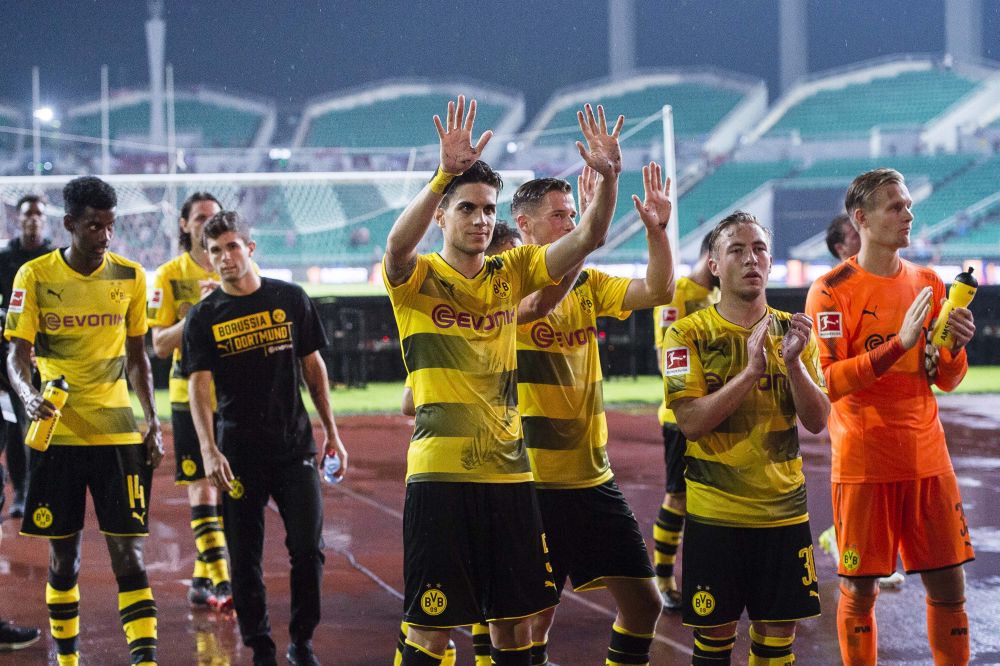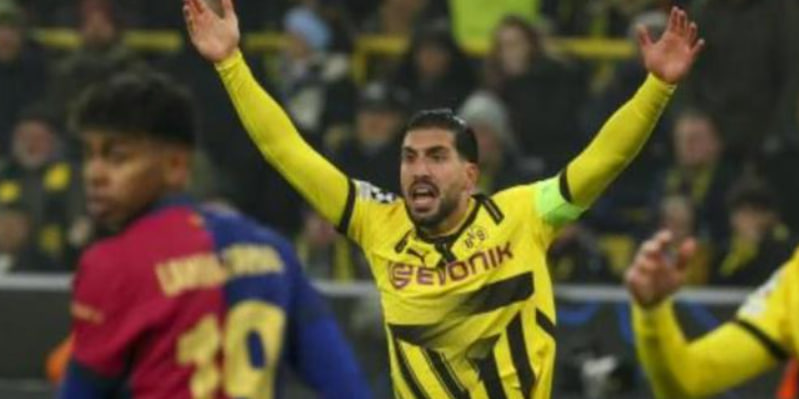If you see a foreigner wearing a Borussia Dortmund jersey while running through the streets of Shanghai these days, he is probably Carsten Kramer – the Managing Director of Borussia Dortmund FC. He is one of the key figures in charge of the club’s international affairs and business development, and is often traveling around the globe, with China being a market he takes very seriously.
Cramer says: “I like Shanghai very much, it has a long history and is modernized at the same time. Every time I go for a morning run, I pass by Jing’an Park, where there are many people playing Tai Chi and doing sports, and I feel that the city is full of vigor.”

He said his last visit to China was in 2019 and he has been hoping to return again since then, especially to Shanghai.
Why does Dortmund value the Chinese market?
In fact, Dortmund has been paying attention to the Chinese market for a long time. As early as 2016 and 2017, they took the first team to China to participate in the International Champions Cup. In the summer of 2017, they also set up a Chinese office in Shanghai. Earlier this year, they opened a youth academy in Zhangzhou, Fujian.
These moves show that Dortmund’s commitment to the Chinese market is continuous and deep. Their goal is not only to promote the team’s brand, but also to build a long-term relationship with Chinese fans, as well as to promote the development of youth soccer.
According to Kramer, there are two main reasons why Dortmund is paying so much attention to the Chinese market:
Of course, in addition to the cooperation at the soccer level, Dortmund also sees the business opportunities in China. Kramer admits that the Chinese market is very attractive to the club. By setting up a Chinese office, they can better keep in touch with their fans and partners.
It’s not enough to just come and play a friendly every two or three years,” he said. We need to make our presence felt by the fans and need more interaction.”
In China, Kramer was impressed by the fans’ enthusiasm
Kramer once went for a morning jog in Shanghai wearing a Dortmund jersey and was greeted by many youngsters who called out the name “Dortmund”. The feeling of closeness made him feel especially happy.
He said: “This shows that our brand is influential here, and the fans are very enthusiastic about us, which makes us more motivated to continue to work in China.”
Currently, the size of Dortmund’s team in China has expanded a lot from when it was first established in 2017. But Kramer thinks it’s not enough, and there’s room for further expansion in the future.
Next month, Dortmund plans to upgrade their office in China into a real company. This means that they will conduct business in China more formally, such as working with local brands and organizing events.
According to Kramer, this will have the advantage of making it easier for Dortmund to communicate with Chinese companies and respond to changes in the market more quickly.
Truly integrating into the Chinese market, not copying the German experience
Dortmund are not just building an office and opening a youth academy in China. They are also trying to adapt their operations to the Chinese market environment.
Kramer said: “We can’t just transfer the way we do things in Germany to China. We have to understand the habits of Chinese fans, the needs of sponsors, and the uniqueness of this market.”
As an example, when it comes to social media, they no longer use the platforms commonly used in Europe, instead choosing Weibo, WeChat, and Jieyin, which are the platforms most commonly used by Chinese users, to publish their content.
He said, “Only by communicating in a way that locals are used to can we really impress them.”
In addition, Dortmund also tries to provide customized merchandise for Chinese fans. For example, they found that many Chinese fans like to drink water “ton ton bucket”, so they launched this product in the official store. Although you can’t see this kind of thing in other countries, it’s very popular in China.
“We’ll listen to the fans and make changes accordingly,” Kramer said. Kramer said, “It’s not just talk, it’s something we’re really doing.”
Dortmund’s deep cooperation with Chinese brands
It is because of Dortmund’s efforts in China that they have attracted more and more Chinese brands to work with them. Currently, more than 10 Chinese companies have become Dortmund’s partners.
The most recent example is TENWAYS, a Chinese company that has become the official electrically-assisted bicycle partner of Borussia Dortmund. Such cooperation not only helps TENWAYS to improve its brand image, but also helps it to enter the European market.
We would like to be a bridge for Chinese companies and help them go global,” Kramer says. Likewise, we also support some overseas brands to enter the Chinese market, such as our partners Siltronic and DB Cargo, and we will do business in China together.”
Youth training cooperation is a priority for Chinese soccer development
For many Chinese fans, one of the most concerned questions is: when will Dortmund play in China again?
Kramer responded, “Because there is the Euro Cup next summer and the Club World Cup in the United States the year after that, it is difficult for the first team to find time to come to China.”
However, he revealed that some retired Dortmund legends will come to China one after another. For example, Weidenfeller will visit Shanghai and Shenzhen next month, while Grosskreutz will come to China in October.
Even more important than the first team’s visit is the news that Dortmund will be playing in Xiamen this October in an U15 international youth tournament. This tournament will not only feature Dortmund’s youth teams, but also youth teams from Europe, the United States, Japan and South Korea.
It’s a chance to show the results of Dortmund’s youth training in China and a good time for Chinese young players to interact with the world’s top teams.
Chinese soccer needs patience and a scientific training system
Currently, Chinese soccer is in a relatively low stage. However, both industry insiders and ordinary fans realize that if you want to revitalize Chinese soccer, you have to start with youth training.
Borussia Dortmund provides a good example in this regard. They have established a youth training academy in Zhangzhou, introducing advanced training concepts and techniques, while also encouraging Chinese players to go out and receive higher level training in Europe.
Last October, a young Chinese player named Wu Hanlin joined Dortmund’s U9 team. Kramer didn’t comment too much on this incident, but his words were impressive.
He said, “I don’t really want to comment on whether a 9-year-old has talent or not. Drawing conclusions too early could put pressure on him and affect his growth instead.”
He also added that Dortmund’s criteria for bringing in players is not the market effect, but the player’s ability, suitability for the team system, and potential for future development.
“We don’t bring in a certain player just to attract attention. We are more interested in the value of the player himself.”
Dortmund stick to their soccer philosophy
In today’s soccer world, where “gold dollar soccer” is prevalent, many clubs rely on money to buy stars to improve their performance. But Dortmund has always stuck to its principles: emphasizing youth training and talent development.
Even at the height of the epidemic, when other clubs were cutting their budgets, Dortmund increased their investment in youth training. They invested 20 million euros in upgrading training facilities and equipment to ensure that the youth training system always stays ahead of the curve.
Kramer believes that this model is the one that is sustainable. We don’t spend a lot of money on players like those clubs in the Middle East,” he said. We believe more in our direction and values.”
He also drew an analogy, “It’s like what you wear every morning, you can’t just wear what others tell you to wear, but you decide for yourself. It’s the same with us, we have to go our own way.”
In his opinion, Dortmund’s core values are the yellow and black uniforms, the passionate style of play, and the strong youth training system. These are the club’s “genes”.
“If we lose these, it will no longer be Dortmund.”
As for the big money attractions in the Saudi league in recent years, Kramer also has his own opinion: “This model that only relies on burning money is not healthy. If there is no solid soccer culture to support it, just spending money cannot last.”
He emphasized, “We’ve proven our philosophy is correct. As long as you are willing to spend time and effort to develop young people, it will definitely pay off in the end.”
Conclusion: Dortmund in China is not just about doing business, it’s about building bridges
Overall, Dortmund’s strategy in China is not just about expanding the market, making money or improving brand influence. They hope to connect Germany and China through the bridge of soccer, promoting cultural exchanges, sports cooperation, and even driving more economic mutual benefits and win-win situations.
From youth training cooperation to brand linkage, from player exchanges to market development, Dortmund is using practical action to tell us: soccer is not just a game, but also a language that connects the world.
